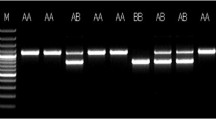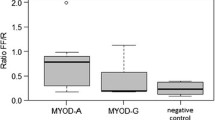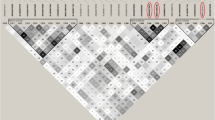Abstract
Because of the central role of Steroidogenic factor 1 in the regulation of the development and function of steroidogenic tissues, including the adrenal gland, we chose the encoding gene NR5A1 as a candidate for stress response, meat quality and carcass composition in the domestic pig. To identify polymorphisms of the porcine NR5A1 we comparatively sequenced the coding, untranslated and regulatory regions in four commercial pig lines. Single nucleotide polymorphisms could be found in the 3′ UTR and in an intronic enhancer, whereas no polymorphisms were detected in the proximal promoter and coding region. A subset of the detected polymorphisms was genotyped in Piétrain x (German Large White x German Landrace) and German Landrace pigs. For the same animals, carcass composition traits, meat quality characteristics and parameters of adrenal function were recorded. Associations with meat color were found for two of the discovered SNPs in Piétrain x (German Large White x German Landrace) and German Landrace pigs but no connections to parameters of adrenal function could be established. We conclude that NR5A1 variations influence meat color in a hypothalamus-pituitary-adrenal axis independent manner and that further regulatory regions need to be analyzed for genetic variations to understand the discovered effects.

Similar content being viewed by others
References
Altuwaijri S et al (2004) Androgen receptor regulates expression of skeletal muscle-specific proteins and muscle cell types. Endocrine 25:27–32
Büdefeld T, Tobet SA, Majdic G (2011) Steroidogenic factor 1 and the central nervous system. J Neuroendocrinol 24:225–235
Caron KM, Ikeda Y, Soo SC, Stocco DM, Parker KL, Clark BJ (1997) Characterization of the promoter region of the mouse gene encoding the steroidogenic acute regulatory protein. Mol Endocrinol 11:138–147
Désautés C et al (2002) Genetic linkage mapping of quantitative trait loci for behavioral and neuroendocrine stress response traits in pigs. J Anim Sci 80:2276–2285
Djurhuus CB, Gravholt CH, Nielsen S, Mengel A, Christiansen JS, Schmitz OE, Møller N (2002) Effects of cortisol on lipolysis and regional interstitial glycerol levels in humans. Am J Physiol Endocrinol Metab 283:E172–177
Ferraz-de-Souza B, Lin L, Achermann JC (2011) Steroidogenic factor-1 (SF-1, NR5A1) and human disease. Mol Cell Endocrinol 336:198–205
Foury A, Devillers N, Sanchez MP, Griffon H, Le Roy P, Mormède P (2005) Stress hormones, carcass composition and meat quality in large WhitexDuroc pigs. Meat Sci 69:703–707
Foury A et al (2009) Estimation of genetic trends from 1977 to 2000 for stress-responsive systems in French large white and landrace pig populations using frozen semen. Animal 3:1681–1687
Grgurevic N, Büdefeld T, Rissman EF, Tobet SA, Majdic G (2008) Aggressive behaviors in adult SF-1 knockout mice that are not exposed to gonadal steroids during development. Behav Neurosci 122:876–884
Hambrecht E, Eissen JJ, Newman DJ, Smits CH, den Hartog LA, Verstegen MW (2005) Negative effects of stress immediately before slaughter on pork quality are aggravated by suboptimal transport and lairage conditions. J Anim Sci 83:440–448
Hanley NA, Rainey WE, Wilson DI, Ball SG, Parker KL (2001) Expression profiles of SF-1, DAX1, and CYP17 in the human fetal adrenal gland: potential interactions in gene regulation. Mol Endocrinol 15:57–68
Hoivik EA, Lewis AE, Aumo L, Bakke M (2010) Molecular aspects of steroidogenic factor 1 (SF-1). Mol Cell Endocrinol 315:27–39
Honikel KO (1998) Reference methods for the assessment of physical characteristics of meat. Meat Sci 49:447–457
Huang N, Dardis A, Miller WL (2005) Regulation of cytochrome b5 gene transcription by Sp3, GATA-6, and steroidogenic factor 1 in human adrenal NCI-H295A cells. Mol Endocrinol 19:2020–2034
Hyun Y, Ellis M, Riskowski G, Johnson RW (1998) Growth performance of pigs subjected to multiple concurrent environmental stressors. J Anim Sci 76:721–727
Ikeda Y, Lala DS, Luo X, Kim E, Moisan MP, Parker KL (1993) Characterization of the mouse FTZ-F1 gene, which encodes a key regulator of steroid hydroxylase gene expression. Mol Endocrinol 7:852–860
Ikeda Y, Shen WH, Ingraham HA, Parker KL (1994) Developmental expression of mouse steroidogenic factor-1, an essential regulator of the steroid hydroxylases. Mol Endocrinol 8:654–662
Ingraham HA et al (1994) The nuclear receptor steroidogenic factor 1 acts at multiple levels of the reproductive axis. Genes Dev 8:2302–2312
Kadarmideen HN, Janss LL (2007) Population and systems genetics analyses of cortisol in pigs divergently selected for stress. Physiol Genomics 29:57–65
Karamucki T, Jakubowska M, Rybarczyk A, Gardzielewska J (2013) The influence of myoglobin on the colour of minced pork loin. Meat Sci 94:234–238
Khani S, Tayek JA (2001) Cortisol increases gluconeogenesis in humans: its role in the metabolic syndrome. Clin Sci (Lond) 101:739–747
Kim J, Cho IS, Hong JS, Choi YK, Kim H, Lee YS (2008) Identification and characterization of new microRNAs from pig. Mamm Genome 19:570–580
Lala DS, Rice DA, Parker KL (1992) Steroidogenic factor I, a key regulator of steroidogenic enzyme expression, is the mouse homolog of fushi tarazu-factor I. Mol Endocrinol 6:1249–1258
Leers-Sucheta S, Morohashi K, Mason JI, Melner MH (1997) Synergistic activation of the human type II 3beta-hydroxysteroid dehydrogenase/delta5-delta4 isomerase promoter by the transcription factor steroidogenic factor-1/adrenal 4-binding protein and Phorbol ester. J Biol Chem 272:7960–7967
Luo X, Ikeda Y, Parker KL (1994) A cell-specific nuclear receptor is essential for adrenal and gonadal development and sexual differentiation. Cell 77:481–490
Mikawa S et al (2007) Fine mapping of a swine quantitative trait locus for number of vertebrae and analysis of an orphan nuclear receptor, germ cell nuclear factor (NR6A1). Genome Res 17:586–593
Miller WL (2002) Androgen biosynthesis from cholesterol to DHEA. Mol Cell Endocrinol 198:7–14
Moeller SJ et al (2010) Trained sensory perception of pork eating quality as affected by fresh and cooked pork quality attributes and end-point cooked temperature. Meat Sci 85:96–103
Mormède P, Foury A, Terenina E, Knap PW (2011) Breeding for robustness: the role of cortisol. Animal 5:651–657
Muráni E, Ponsuksili S, Schellander K, Wimmers K (2006) Association of corticotropin-releasing hormone gene variation with performance and meat quality traits in commercial pig lines. Anim Genet 37:509–512
Ninomiya Y, Okada M, Kotomura N, Suzuki K, Tsukiyama T, Niwa O (1995) Genomic organization and isoforms of the mouse ELP gene. J Biochem 118:380–389
Nomura M, Bärtsch S, Nawata H, Omura T, Morohashi K (1995) An E box element is required for the expression of the ad4bp gene, a mammalian homologue of ftz-f1 gene, which is essential for adrenal and gonadal development. J Biol Chem 270:7453–7461
Ramayya MS, Zhou J, Kino T, Segars JH, Bondy CA, Chrousos GP (1997) Steroidogenic factor 1 messenger ribonucleic acid expression in steroidogenic and nonsteroidogenic human tissues: northern blot and in situ hybridization studies. J Clin Endocrinol Metab 82:1799–1806
Rice DA, Mouw AR, Bogerd AM, Parker KL (1991) A shared promoter element regulates the expression of three steroidogenic enzymes. Mol Endocrinol 5:1552–1561
Sadovsky Y et al (1995) Mice deficient in the orphan receptor steroidogenic factor 1 lack adrenal glands and gonads but express P450 side-chain-cleavage enzyme in the placenta and have normal embryonic serum levels of corticosteroids. Proc Natl Acad Sci U S A 92:10939–10943
Shinoda K et al (1995) Developmental defects of the ventromedial hypothalamic nucleus and pituitary gonadotroph in the Ftz-F1 disrupted mice. Dev Dyn 204:22–29
Simmons PS, Miles JM, Gerich JE, Haymond MW (1984) Increased proteolysis. An effect of increases in plasma cortisol within the physiologic range. J Clin Invest 73:412–420
Sugawara T, Kiriakidou M, McAllister JM, Holt JA, Arakane F, Strauss JF 3rd (1997) Regulation of expression of the steroidogenic acute regulatory protein (StAR) gene: a central role for steroidogenic factor 1. Steroids 62:5–9
Swatland HJ (2004) Progress in understanding the paleness of meat with a low pH. S Afr J Anim Sci 34(2 Suppl):1–7
Weiler U, Claus R, Schnoebelen-Combes S, Louveau I (1998) Influence of age and genotype on endocrine parameters and growth performance: a comparative study in wild boars, meishan and large white boars. Livest Prod Sci 54:21–31
Wong M, Ramayya MS, Chrousos GP, Driggers PH, Parker KL (1996) Cloning and sequence analysis of the human gene encoding steroidogenic factor 1. J Mol Endocrinol 17:139–147
Woodson KG, Crawford PA, Sadovsky Y, Milbrandt J (1997) Characterization of the promoter of SF-1, an orphan nuclear receptor required for adrenal and gonadal development. Mol Endocrinol 11:117–126
Yoshioka G, Imaeda N, Ohtani T, Hayashi K (2005) Effects of cortisol on muscle proteolysis and meat quality in piglets. Meat Sci 71:590–593
ZDS (2007) Richtlinie für die Stationsprüfung auf Mastleistung, Schlachtkörperwert und Fleischbeschaffenheit beim Schwein. Ausschuss für Leistungsprüfung und Zuchtwertschätzung, Bonn
Zubair M, Ishihara S, Oka S, Okumura K, Morohashi K (2006) Two-step regulation of Ad4BP/SF-1 gene transcription during fetal adrenal development: initiation by a Hox-Pbx1-Prep1 complex and maintenance via autoregulation by Ad4BP/SF-1. Mol Cell Biol 26:4111–4121
Acknowledgments
The authors thank Angela Garve and Marlies Fuchs for excellent technical help.
Author information
Authors and Affiliations
Corresponding author
Additional information
Communicated by: Maciej Szydlowski
Electronic supplementary material
Below is the link to the electronic supplementary material.
Online Resource 1
Information on identified single nucleotide polymorphisms of the porcine NR5A1 (PDF 101 kb)
Online Resource 2
Association between the analyzed SNPs and parameters of meat quality and carcass composition (PDF 97 kb)
Online Resource 3
Estimated allele substitution effects of the analyzed SNPs (PDF 95 kb)
Rights and permissions
About this article
Cite this article
Görres, A., Ponsuksili, S., Wimmers, K. et al. Genetic variation of the porcine NR5A1 is associated with meat color. J Appl Genetics 57, 81–89 (2016). https://doi.org/10.1007/s13353-015-0289-2
Received:
Revised:
Accepted:
Published:
Issue Date:
DOI: https://doi.org/10.1007/s13353-015-0289-2




